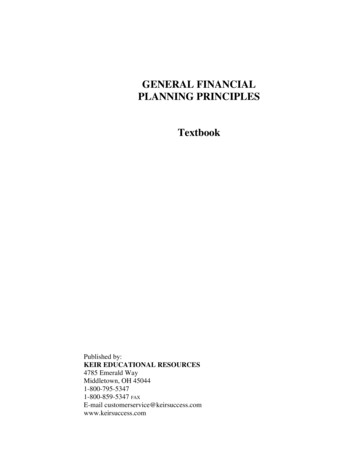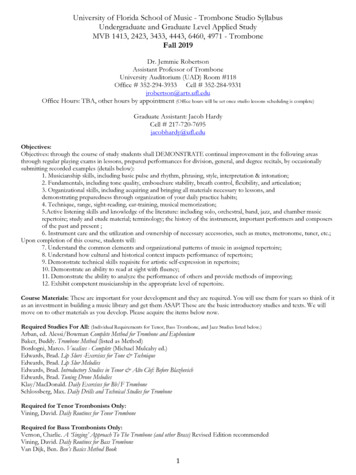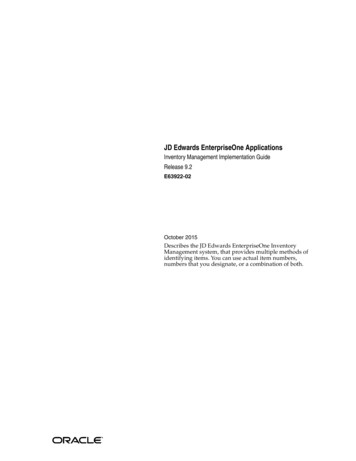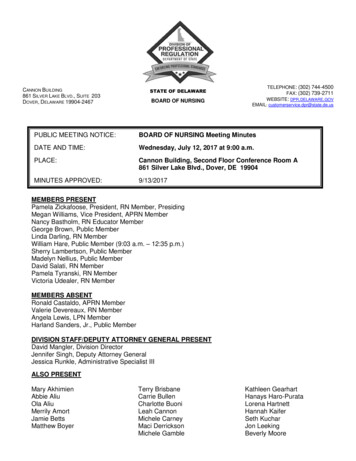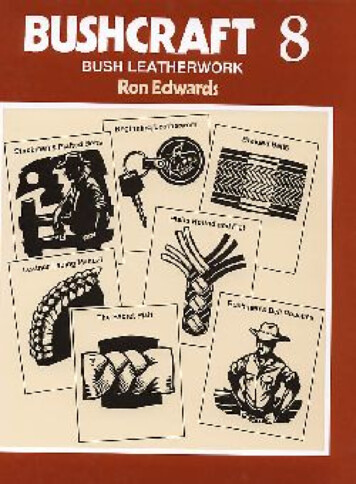
Transcription
BUSH LEATHERWORKRON EDWARDS
By the same authorAUSTRALIAN TRADITIONALBUSH CRAFTSSKILLS OF THE AUSTRALIANBUSHMANMAKING A STOCK SADDLETHE AUSTRALIAN YARNOVERLANDER SONGBOOKMUD BRICK AND EARTHBUILDING THE CHINESE WAYYARNS AND BALLADS OF THEAUSTRALIAN BUSH
THE RAMS SKULL PRESS
In 1982 I began writing a series of small books dealing withvarious aspects of leatherwork concentrating on the specialskills and techniques that have been developed in theAustralian bush over the past century.Fortunately these skills have not vanished, and infact interest in them seems to be growing. There are a numberof plaiters working today whose skills equal that of any of thegreat names from the past, and many bush people are onceagain making their own leather gear. We know this from theincrease in orders from outback areas of north Queensland thatcome into our saddlery business in Cairns.At present I have written and published elevensmall books on leather, and they are all in this one volume, plusa section on making thread, taken from my book 'Making aStock Saddle.Ron Edwards.November 1984This eBook version was scanned and proofed by Ten80. These books arebecoming hard to get even in Australia. So I hope the by converting themto electronic format that I can introduce new readers to the joys of RonEdwards' unique style. After all, the more of us wanting his titles, themore likely there are to be reprints.If you enjoy this book, please strongly consider sending Ron a donation atthe address below, and ask for copies of his other books - they are wellworth the reading too.I hope you find this, my first scanning attempt, of use.Thanks,Ten80.Copyright Ron Edwards 1984THE RAMS SKULL PRESSBox 274 KurandaQld 4872AustraliaPh (070) 937474Also obtainable fromCRAFT SHOP SADDLERY61 Grafton St Cairns 4870ISBN 0 909901 47 3
1. STOCKMEN'S PLAITED BELTSAnother use for beltsSelecting the laceCutting lace by handThe stabbed block guideThe split twig guideFingers only methodStandard flat plaiting techniqueEight plaitTen plaitTwelve plaitSixteen plaitLosing the sequenceCalculating the amount of laceTwin ring beltFourteen plaitEighteen plaitGetting tension on plaited beltsReversing the faceFinishing offThe keeperLoose keeperSmoothing and stretchingBuckle beltFixed keeperPlaiting patternsPatterns in generalCrocodile ridge plaitRaised edge plaitTriple ridge plaitSome variationsHat bandsWatch bands4. BUSHMEN'S BELT 252627282933333436362. BRAIDED BELTSRound edge braidingSingle strand centre braidVine & flowers patternTwelve point braidWide braidingCovered bucklesA braided snake394041424345463. THE SECRET PLAITThree plaitEleven plaitTwenty-one plaitAllowing for shrinkageThree plaitFive plaitA dog collarA collar for a small dogAnother way to do three plaitSeven plaitNine, eleven & thirteen plaitHomemade gang cutterGulf knotTrinity knot4848484949525657586063646566Pouches sewn on the beltA 3-pouch beltPouch with a studPouch worn on the frontPlaited knife pouch fixed to beltmaterials neededPlaited knife pouch, looseStandard knife pouchSimple pouchDouble pouchRabbiter's pouchSailor's knifePlaited pouchWatch pouchDrop-down pouch6969727374747881838384848591925. LEATHER LACINGWhip stitchWide whipMummy wrappingBack whipCross stitchRound braidSingle cordoverDouble cordoverTriple cordoverLazy SDot stitchBaggin's stitch94959798991001021031051061081086. PLAITS ROUND & FLATThree plaitFour plait(roundCrown knotDouble four plaitFive plait(round)Six plait(round)Seven plait(round)Eight plait(round)Eight plait(another method)Twelve plait(round)CoachwhippingShort whippingA dog leadLong whippingGeneral rule for flat plaitsThree plait(flat)Four plait(flat)Five plait(flat)Six plait (flat)Seven plait(flat)Eight plait(flat)Ten plait(flat)Twelve plait(flat)Fourteen plait(flat)Sixteen plait(flat)A useful plaiting tip1111111121131141151151161171171171 181191211221221221231231241241241251251251255
7.WHIPMAK1NGPART 1Basic stockwhipsDimensionsCutting the strandsSkivingRolling the bellyAvoiding tanglesPlaiting the whipPlaiting soapAttaching the fallRolling the whipMaking the crackerSpeeding up the g off the cracker137Fastening the crackerMaking the handleAttaching the keeperAttaching whip & handleCovering the handleForming the knobSix plait whipWorking the six plait137138138139140141143143Changing from 6 to 41448.W H I P-M A K I N GPART 2Kangaro o hide stockwhipsMaterials neededThe coreThe filler and belly plaitThe bolsterThe top plaitThe top plait, g reasing strandsAvoiding tanglesBroken strandsJoining without glueA faster joinChanging from 1 2 to 10 plaitChanging from 10 to 8 plaitChanging from 8 to 6 plaitThe fallThe handleA h a l f -p l a i t e d h a n d l eFrench whippingAppendix 1Appendix 2 - All kangaroo hide whipAppendix 3 - Cowhide bellyA p p e n d i x 4 - W h i p f r o m p r e -c u t l a c eMaking a bull whipSnakewhipCovering the 163168168172172173174175180186HOMEMADE TOOLSHole punchMalletStampsEmbossing toolsCutting strapsPlough gaugeEdge shaveEdge creaseWooden edge creaseLeather creaseRaceMarking wheelRound knifeLacing fidAwlStitching awlBone 205206207Multiple slit punchEdge polishing ironLace needles20820820910. ROLLING A THREADSewing213Sewing thick leatherAnother way of beginningB a c k- s t i t c h i n g w i t h o n e n e e d l e21621721811.SADDLE REPAIRSSimple saddle repairsSewing the panel backRepairing the treeReplacing deesRepairing a torn flapReplacing girth strapsSeat breaking loosePutting on a new seat12.220225228230231232234235COUNTER-LINING STOCK SADDLESMaterials neededBeginning the patchingPreparing to patch panelSewing back patch to back facingPatch on panel edgeSewing in channel materialPinning patches in placeStitching patchesM aterials for counter -liningBegin counter-liningConcealed stitchSerge sewn & filling begunFilling top & bottomStart of quiltingUsing double ended needleUsing seat 8
17
STOCKMAN' S PLAITEDBELTSSTOCKMAN' S PLAITEDBELTSWhen I first printed the booklet onplaited belts I used a sketch of astockman friend, Rob Cheerio, on thecover.When it came time to print a8STOCKMAN' S PLAITED BELTSSTOCKMAN ' S PLAITEDBELTSsecond edition I added a few yearsonto him, much to his disgust.In later printings he has got olderand older, until now he looks justabout ready to retire.
FOREWORDOver the years bushmen have developed various crafts that aretypically Australian, and one of these is the plaiting of kangaroo hidebelts. Braided belts of various types are found in other countries, butthe Australian variety is quite distinctive.These belts are extremely comfortable, very flexible andimmensely strong. Kangaroo hide is said to be the strongest leatherin the world for its thickness, and yet is very easy to work with.The stockman's belt evolved generations ago, probably in someisolated outback cattle camp during the wet season. At this time ofthe year when outs ide work becomes impossible the men repairharness and make up gear for the coming season. There is plenty ofspare time to fill in, and so plaited work can be undertaken, such asthe making of stockwhips, the best of which are also worked withkangaroo hide.Belts are made in two forms, with a conventional buckle or witha pair of rings. The twin ring buckle is the most characteristic form,the rings usually being brass and from an old bridle. This styledoubtless originated from necessity as there are usually a few bridlerings to be found around any station even when buckles are scarce.Besides the use of kangaroo hide the stockman's belt alsodiffers from other forms in the way that it is begun. In other parts ofthe world the usual custom is to begin a plaited belt from the buckleend, but stockmen begin from the point.This may seem to be a little complicated the first time it isattempted, but after only a few belts it will be found to be relativelyeasy. Once the point has been formed the rest of the plaiting is quitesimple.ANOTHER USE FOR BELTSOne day when I was doing some plaiting a bushman camealong and told me an odd tale about plaited belts. He said that inthe early days in western New South Wales and Queensland it wasagainst the law for a swagman to carry a bridle amongst his gear.This was to discourage horse stealing.To get around this problem the travellers would use two orthree plaited belts to tie up their swag, and another around theirwaist, and with these they could soon put together a simple bridleusing a scrap of fencing wire as a bit.9
This simple type of bridleis known to most bushworkers. It can be made witha pair of belts as shown in thesmall sketch , or a third beltcan be used to act as browband and cheek strap. Rope isused for reins. I have made abridle in this manner, and it isquite practical with a quiethorse,thoughnotrecommended for extended use.10
SELECTING THE LACEKangaroo lace is usually sold by the hank, and at thepresent time is generally found to be labelled in a rather odd way,with the length being given in metric measurements but the widthin Imperial. The average hank is either 11 or 23 metres long andcomes in three widths, 1/8", 3/16" and 1/4". In time these willdoubtless become 3mm, 4.5mm and 6mm.The widest lace is not generally used for belts, beingconsidered too wide, while the narrowest is only used by peoplewith plenty of time on their hands. The middle width is generallychosen by people who have to do a lot of plaiting, though theyconcede that the narrow lace looks the best.When choosing lace look for a good finish, uniform widthand smooth edges. Reject lace that has a rough hairy back as thisis inferior quality.Without taking the wrapper off the hank locate one of theends of the lace and give it a gentle tug. If you have selected theright end the lace will pull out from the hank in a continuous flow,and the whole hank can be used up without the wrapper beingremoved.CUTTING LACE BY HANDIn the bush most lace is still cutby hand, often using skins that havebeen tanned on the property .The skin is laid on a bench and acircle is drawn on it, using a compassquickly made up with a nail, a pieceof string and a pencil. The circle isthen cut out.11
Experience has shown that the circle is the only practicalshape from which to cut lace. If for instance a shape is cut such asthat shown on the right in order to use up the maximum area ofskin, then it will be found that a certain amount of distortion willtake place on each revolution of the skin until one is left with ashape something like the shaded area in the centre which is quiteimpossible to work.A circle however can be cut until only a coin sized pieceremains. The trimmed parts are also not wasted, short lengths oflace can be cut from them, and itemssuch as watch bands made from thesmaller pieces.The most convenient way tocut lace is with a special lace cuttermade for the job. The only good lacecutter that I know of is distributed bystockmens' outfitters, R. M. Williams.This ingenious small tool ismade from iron and fits on the leftthumb.A piece of razor blade is used as acutter, and a small screw on the top allows one to adjust thewidth to be cut, while the roller next to the blade is adjustedaccording to the thickness of the leather.The circle of leather is fixed to the bench with a tack in thecentre with the edge overhanging the bench a little on theoperator's side. The first couple of centimetres of lace are cutwith a knife and fed into the lace cutter.As the newly cut lace is pulled from the cutter the leathercircle revolves rather like a gramophone record. As the circle getssmaller it is necessary to re -position it from time to time.The sharper the blade the e asier it is to use, and we find itbest to change the position of the blade or replace it after eachskin.12
a skin will vary, but we often obtain100 - 200 metres of 3mm lace from asingle hide.One secret when cutting with thistool is to pull the lace slightly awayfrom the circle, this lessens thechance of the blade running off andcutting uneven widths.I n t h e o u t b a c k l a c e i s frequentlycut entirely by hand or with a simplehome made cutting guide. Theessentials fo r this work are steadyhands and a very sharp knife. I havewatched a stockman sitting undera tree during the dinner breakspend a full hour putting a goodedge on his penknife, and my oldringer mate'Slippery Sam' Callope would thinknothing of spending two hoursto sharpen a round knife.For cutting lace the knife must besharp enough to readilyshave the hairs on the arms, anything less and it is not worthbeginning .THE STABBED BLOCK GUIDE Theknife point is driven into a blockof wood, the dimensions of thewood are not important, just aslong as it can be held in the hand.The thumb nail is pressed on thewood to act as a guide and the firstfinger curled over to keep theleather flat against the surface o fthe wood.13
THE SPLIT TWIG GUIDEA stout twig is split and a match- stick put in to keep the splitopen. The match is trimmed down to the thickness of the leather tobe used. The knife is held as shown in the sketch, this takes somepractise, and the base of the handle is usually kept steady by resting iton the knee. The lace passes between the blade and the match- stick.FINGERS ONLYMETHODWhip makers often trimleather entirely by handwithout any form of guide,and each man evolves hisown style. One man'stechnique may be of no useto another.the sketch the insideedge of the thumb nail isbeing used as the guidewhile the first finger sits on top of the leatherand holds it in place. The other fingers hold the knife.In this case the lace is not pulled away from thecircle, instead it is held close against it. This is not aneasy style to master.This is the cutting methodshown to me by Lindsay Whiteman ofTownsville. Sit down and put thehide on the bench. The thumbnailof the knife hand acts as a gaugewhile the other hand pulls thelace.The knife needs to beextremely sharp to use thistechnique.14
STANDARD FLAT PLAITING TECHNIQUEMany beginners do not realize that the standard flat plaittechnique is the same whether it be a 4 plait or a 24 plait. This isillustrated in the sketch which shows the most common plaits usedin belts, 8, 10, 12 and 16. Note that each is formed in the samemanner.It is best to develop theEight plaithabit of always beginning ono ne side - left or right as youprefer. The main thing is to establish aregular working pattern. I always begin onthe left.15Notice that in every case the lefthand lace goes under-over- under- overand so on until the middle is reached.The right hand lace is then broughtacross in an over- under-over- undersequence.
LOSING THE SEQUENCEIf a belt has been put aside for some time you will haveforgotten which strand is the next to be worked, and this is wherethe practise of always beginning from the left pays dividends.Count the strands in each hand, if they are equal then beginby bringing the left strand across. If there are more in the righthand than the left then bring one across from the right.If there are more in the left hand than the right then you havegot out of sequence somewhere. Keep on bringing strands downfrom the left until you have the same number in each hand. Nowbegin the sequence by bringing down one from the left and thenone from the right.CALCULATING THE AMOUNT OFLACE NEEDEDThere are a number ofthingstoconsiderwhencalculating the length of laceneeded for a belt. Beside thewaist measurement there is extralace needed for fastening on therings or buckles, and there isalso the question of how muchlength is going to be lost in theactual plaiting.Also remember that youdouble your lace, in other words youuse 5 strands to make a 10 strandbelt.There is a simple method of working out the length of laceneeded. Take the person's waist measurement and multiply it by 3.The scale below gives the person's waist measurement , the numberof strands to cut and the length of the strands.Waist6 plait8 plait10 plait 12 plait 16 plaitmeasureThis calculation takes care of the extra lace needed forpoints listed above. Measurements in millimetres.16the three
The twin ring belt is a real bushman's belt. Instead of using abuckle it is fastened with a pair of rings, usually brass rings from abridle.The first step in making a belt is to calculate the lengthr e q uired as explained above. Let us suppose that you havemeasured the waist as one metre and you wish to make an 8 plaitbelt. To do this you will need 4 lengths of lace each 3 metres long.For the beginner thebest plan is to put a nail into t h et o p o f a bench or table andform the point of the belt aroundthis. Once you have made a fewbelts you will find t h a t t h i s i sn o l o n g e r necessary, and thepoint of the b e l t c a n b e f o r m e dwhile holding all the lace in16the hand.The sketches show thebeginning of an 8 plaitbelt. To do a 10, 12 or 16 simply add in more strands as desired.The first strand of lace is looped around the nail, making sure thatthe good side of the leather is facing upwards all the way around.If the leather is very thick it may help to thin it a little just at thepoint as shown in t he sketch, but this is not generally necessary.19The other strands are now added in as shown.17
21Beginning on the left side at the top turn down all the strands inan under- over- under sequence.The right side is then turned down in the same way. Now thecentre left strand is moved across as shown by the dotted line,then the right side inner strand is brought across as shown in thenext drawing.3018Each strand is broughtover in sequence. Oncethis has been done thework can be removedfrom the nail andcarefully pulled firm tomake the point of thebelt.
Once the point has beenshaped the plaiting of the beltcan go ahead. Beginning on theleft the outside strand isbrought to the centre asindicated by the dotted line.Then the right hand outsidestrand is brought to thecentre.32Here is a sketch of a 12strand plaiting sequence toshow that the same basic stepsare followed no matter howmany strands are used.FOURTEEN STRANDSEIGHTEEN STRANDS19
I have found the main thing is toget the end of the belt fixedfirmly to something while you areplaiting.Some people put a wire hookthrough the belt to hold it, but I donot like this as it can stretch the beltat this point and leave a hole.It is also possible to put the end ofthe belt in a drawer and close thedrawer. This jams the end of the beltand holds it firm.I prefer to hold the end of the beltwith a length of soft cord. This canbe moved down as work proceeds anddoes not mark the leather in any way.Lindsay Whiteman, a plaitingexpert from Townsville, Qld, alsopassed on a couple of hints f o rtting an even tension.First, he rubs the lace with muttonfat or leather dressing before workingwith it, and says that this helps get atighter plait.He also tightens up the strands asillustrated. The top strand is pulledtight only when you are about to workwith it , but the working through isleft loose. He claims that this gives amuch more even finish.pulltightthenworkthroughlooselyREVERSING THE FACEThe twin ring belt is fastened as is shown in fig.36. If specialsteps were not taken then the point of the belt would now beshowing the rough side of the leather facing outwards. To avoidthis the whole face of the belt is reversed. This is illustrated infig. 37, the shaded section representing the rough side of theleather.3720
Reversing begins when140 mm of belt has beenplaited.There is no change in theplaiting sequence, but as eachstrand is picked up it is givena twist as shown in fig. 38 sothat the rough side of theleather is now showing.Once all the strands havebeenreversedplaitingcontinues as before until thebelt is completed.3821
FINISHING OFFWhen the wanted length has beenplaited, slip a pair of rings over the end of the belt. Solid brassrings look better than plated ones, and they look better if theymake a neat fit and are not too large in diameter.Turn the belt over and tuck in the two ends as shown in fig 40*Now the remaining loose strands can also be tucked in, followingthe pattern of the strands below.39When sufficient length has been plaited back to firmly securethe rings the ends are trimmed off.22
THE KEEPERA keeper is now needed to hold the loose end of the beltneatly in place. The keeper can be loose or plaited permanentlyinto the belt. The latter is best as loose keepers are easy to lose.A fixed keeper is made by slipping two scraps of lace into thebelt about 190mm from the point. This is done on the back of thebelt. These are then folded as in fig. 43 so that the good side of thelace is facing you.An ordinary 4 plait is commenced as shown in the sketches.The belt is turned over so that the keeper goes across thefront of the belt as in fig. 46.The end is plaited into the back of the belt as shown in fig.47,and plaited in far enough to make it firm.4623
LOOSE KEEPERA loose keeper can be made in a few minutes if these steps arefollowed. Take two scraps of lace and fold them together asshown in fig. 48. The good side of the lace is facing up.Now follow the sequence shown by the dotted lines. Whensufficient length has been plaited form a loop and work thestrands in as shown in fig. 52. Work the strands in far enough tomake them firm then cut off the surplus.If the beginning of the plaiting forms an undesirable lumpinside the loop then this can be trimmed off as well, but this is notusually necessary.There are other methods of beginning a loop, but this is thequickest and easiest.5324
SMOOTHING ANDSTRETCHINGThe final step in making a belt is tostretch and smooth it. This is done byrubbing the face of the belt ove r a smoothedge, a broom handle or the edge of atable or chair are the most commonly used.Thebelt is stretched at'the same time, and thistreatment tightens up theplaiting and smooths down thesurface at the same time.If the belt needs polish then Dubbin or boot polish are best.However in the bush saddle dressing is more usually applied, andthis is quite satisfactory, though it does not bring up a high polish.While the twin ring belt is the most characteristicallyAustral ian style of belt the use of buckles is also common. Plainbrass full swage bridle buckles are often used, or any other readilyavailable harness buckle, such as brass girth buckles.Holes are not punched in the belt to take the tongue of thebuckle, it is simply pushed through the weave. However somecommercially made belts do have eyelets fitted to them, a quiteunnecessary feature.The belt is plaited in the same way as described earlier,except that the lace is not reversed at the point end. The goodside of the lace faces upwards for the whole length of the belt.25
When the end of the belt isreached the buckle is slipped inplace as shown in fig.56, the beltturned and plaited back asdescribed earlier. Fig. 57 showsthe first two laces plaited bac k,and the other strands are workedthe same way. FIXED KEEPERThe keeper for a buckle belt canbe made as described earlier, or itcan be worked up from the surpluslace left whenplaitinghasbeen completed.Whenskilledplaiters use this method theybegin the plaiting of the belt withfour strands about 150mm longerthan the rest. By doing this theyend up with four long strands allready to use for a keeper when thebelt has been completed, as shownin fig. 58. Thisisnotsoimportant on an 8 plait belt,but on a 16 plait it means asaving of nearly 2 metres oflace.When this type of keeperis made the plaiting back fromthe buckle extends a littlefurther than usual so that thekeeper will be about 80 mmfrom the buckle.All the other unwantedends of lace are trimmed flushand then the four remainingstrands are placed as shown bythe dotted lines. Once thishas been done plaitingcontinues. (see figs. 46-47 formethod of finishing).26
PLAITING PATTERNSThe majority of stockmen prefer a plain belt, but patternedbelts are not uncommon. Some plaiters prefer a subtle effect, usinglight tan and mid tan lace, while others strive for a more dramaticeffect using the lightest colours against the darkest available. Thesketches show the most popular patterns.Fig. 60. By alternating the strands a striped effect is created.Fig. 61. By dividing the colours into two bunches a brokenpattern is created. On a 12 plait belt using light tan and mid tan apattern is produced that looks something like snake skin.62Fig. 62. When only a single coloured strand is used a diamondpattern runs the length of the belt. In this case the single strand isdark.Fig. 63. When the single strand is light a more striking pattern ofdiamonds is created.27
Fig.64. The more strands used in the belt the more thepattern can be altered, as in this example of a 12 plait.Fig.65. It is possible to alter the pattern in the course ofplaiting, but this is not often done as there is usually a rathermessy section where the patterns change over. In this case the belthas begun as in fig.60.Then gradually as plaiting continues one strand is crossed overthe other until all the light strands are in one hand and all thedark ones in the other. Now a totally different pattern is created.In order to avoid the confused area where the patterns changesome plaiters cut the strands and glue on strands of the desiredcolour, and can thus change the pattern instantly. Whip makersoften use this technique.PATTERNS IN GENERALAlthough a variety of patterns can be created bychanging the colour of the lace as work proceeds mostplaiters prefer to use the basic patterns given above. Ingeneral they use subdued colours, usually light, middleand dark tan.When brighter colours are chosen they are almostalways on the warm side of the spectrum, dark red,warm yellow and so on. Blues and greens are avoided.The mixing of three or more colours is alsofrowned on, unless they happen to be all shades of tan.28
66Fig.66. This pattern is createdby making one half of the lace adarker colour than the other or byjoining together dark and light lace.The glue used for joining the lacedoes not have to be anything specialas long as plenty of overlap is used,for the plaiting will hold the lacefirmly in place.If the lace is glued it is a goodidea to do the gluing off centre, (thedottedlinerepresentsthecentre). Not only does this allowthe point of the belt to be a solidcolour but it avoids the likelihoodof a glued section getting scuffedapart at the point of the belt.Beginning with all the darkstrands in one hand and all thelight ones in the other aninteresting pattern is created.By changing to a crocodile ridgeplait, as described in the followingsection, the belt will be divided intotwo bands of solid colour as shown.The crocodile ridge is a distinctive form ofplaiting in which a ridge is formed down thecentre of the belt. When this is well done itresembles the ridges along the back of acrocodile.There are a number of ways of forming thisridge, but I will describe the one most commonlyused by bush plaiters.29
The basic principle offorming the ridge is shown in figs.68 and 69. Fig.68 shows thenormal plaiting technique inwhich the strands go from o n eside of the belt to the other.Fig. 69 shows the crocodileridge. Notice that the strands donot go from side to side but instead meet in the middle and thengo back to the same side. Where the leather wraps around thestrand from the opposite side it buckles up a little, and this formsthe distinct ridge down the centre of the belt.It is not convenient to run a crocodile ridge the entire lengthof a belt as the ridge would interfere with the belt slipping throughthe buckle, and so the belt is begun and ended as an ordinary flatbelt as described earlier.Some plaiters do the flat plait and then go directly into thecrocodile ridge, but this is a poor practice as the belt will be seento narrow at this point. A well made belt will introduce an extrastrand for the length of the ridge and so keep the belt a uniformwidth.Fig.70. Having plaited at least 200mm of ordinary plaiting anextra strand is folded in as shown.70Figs 71 & 72. Theoutside strandsarebrought across as shown. Notethat the strands are only bentin the centre, they are nottwisted over in any way.30
Figs 73 - 76 This shows the basic method of working the ridge.Before the buckle end of the belt is reached ordinary flatplaiting is resumed, and so the two ends of the extra strand mustbe hidden. Fig.77 shows how the left strand comes across and goesbeneath the centre strand.Fig. 78 shows the right strand coming across and sitting ontop of t h e c e n t r e s t r a n d .31
In this way the belt is brought back to its original number ofstrands and so plaiting goes on in the normal way.After a few passes the lower strand of the doubledstrands can be trimmed off.The belt is now completed in the normal way.32
RAISED EDGE PLAITThe raised edge plait is known to most good bush plaiterseven though they may seldom use it. The method is s i m p l e ,instead of b e g i n n i n g w i t h t h e o u t s i d e s t r a n d t h e s e c o n d s t r a n di s p i c k e d u p . This is bent as shown in fig.81 and neatly foldedaround the outside s t r a n d , t h u s f o r m i n g a r i d g e .Although these variousridge patterns are simple enough theyonly look g o o d when done by a skilledplaiter a s t h e e f f e c t r e l i e s o n uniformpressure and precise positioning.81Fig.82 gives an idea oft h e f i n i s h e d e f f e c t . T h e b e l t is startedand finished as an o r d i n a r y f l a t p l a i t .TRIPLE RIDGE PLAITThis only looks good when do n eo n a 1 2 p l a i t b e l t o r o ver.I t is e a s y e n o u g h t o d o o n c e ac e r t a i n a m o u n t o f s k i l l i n p l a i t i n g ha s b e e n a c h i e v e d , t h o u g htime consuming. It simply consists of a ra i
small books on leather, and they are all in this one volume, plus a section on making thread, taken from my book 'Making a Stock Saddle. Ron Edwards. November 1984 This eBook version was scanned and proofed by Ten80. These books are becoming hard t
